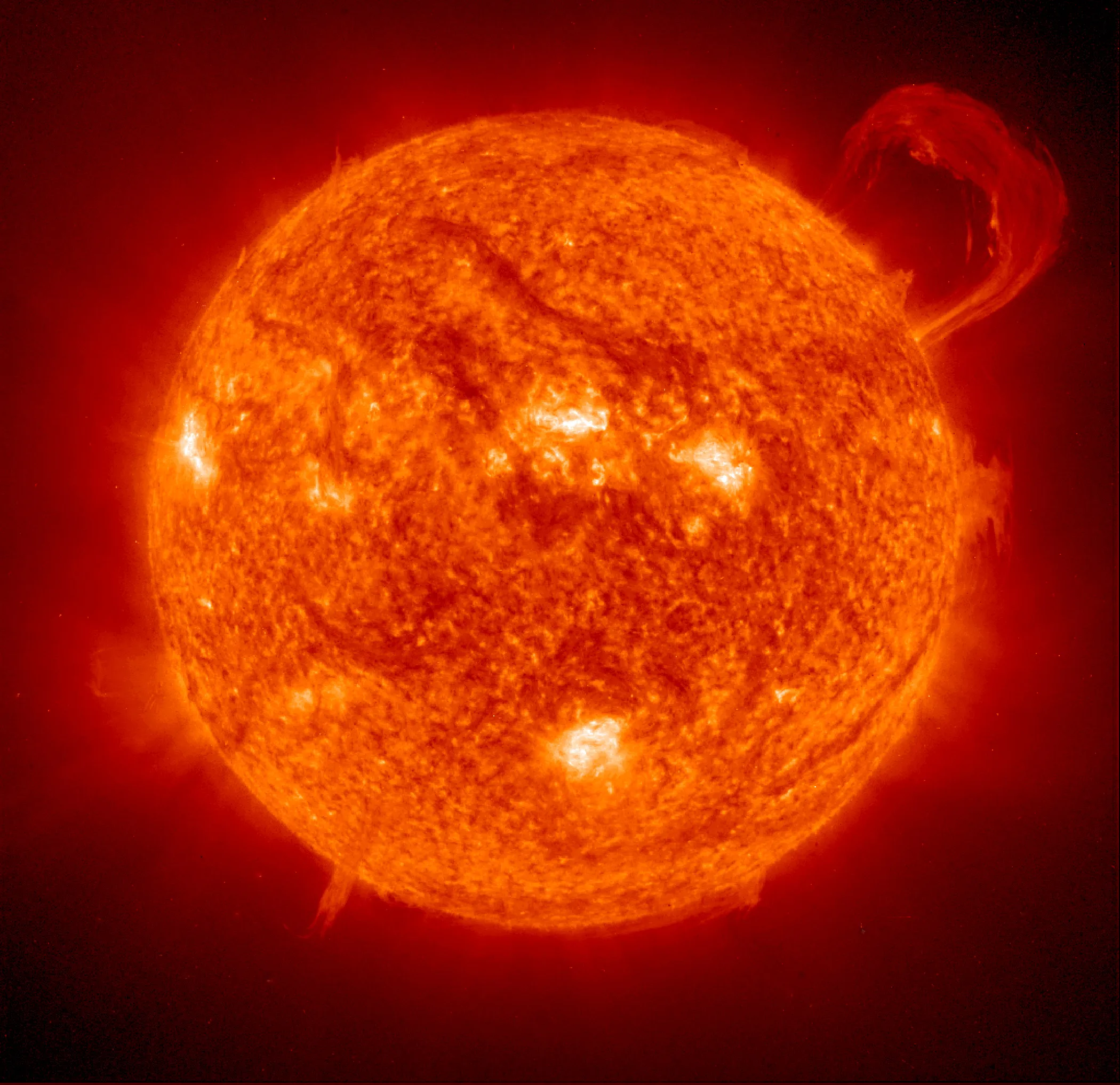Get ready for an adventure through the vastness of space! We’re about to explore the Sun, the fiery heart of our solar system. It’s a cosmic powerhouse that influences not just our planet, but everything around it. From flares to sunspots to magnetic storms, the Sun puts on a dazzling display of energy that shapes our cosmic neighborhood. Join us as we dive into the Sun’s cosmic dance, where it weaves a tapestry of energy and influence that affects everything in its path.
Sun in Space: Our Guiding Star in the Cosmic Tapestry
Imagine the vast expanse of space, a realm where celestial wonders ignite our curiosity. Among the countless stars, one holds a special place in our hearts: our sun. A giant ball of glowing plasma, the sun anchors our solar system in a harmonious dance, guiding us through the cosmic void.
This celestial behemoth, nearly a hundred times larger than our planet, holds us captive in its gravitational embrace. With its immense pull, it dictates our orbit and the orbits of seven other planets, orchestrating an intricate ballet in the heavens.
Our sun is a modest star in the grand scheme of things, nestled within the majestic spiral arms of the Milky Way. Yet, its radiance sustains life on Earth, providing vital energy that nurtures every living creature. As it journeys around the galactic center every 200-250 million years, it carries us and our celestial neighbors in its luminous train.
Scientists have dedicated years to unraveling the mysteries of this celestial wonder. Missions such as Parker Solar Probe, Solar Orbiter, and Solar Dynamics Observatory have ventured close to the sun, braving its intense heat and radiation to unravel the secrets it holds.
Through their daring explorations, we have learned of the sun’s dynamic flares, sunspots, and magnetic field. These phenomena not only impact our planet but also shape the vast expanse of space that surrounds us.
By studying the sun, we not only deepen our understanding of our cosmic neighborhood but also forge a connection to the celestial tapestry that connects us to the universe. Its presence reminds us that we are part of something much grander, a celestial dance that has been unfolding for eons.
Did you know that about 1.3 million Earths would fit inside the Sun? Find more surprising facts like this by reading how many Earths can fit in the sun.
Also, if you are curious about how many Earths can fit inside the Sun while playing BitLife, we have an article covering that too! Check out how many Earths can fit in the sun bitlife.
The Sun is a star, and it’s the center of our solar system. It’s a hot ball of glowing gases that emits light and heat. The Sun is much bigger than Earth. In fact, it’s about 109 times bigger than Earth. To learn more about how big is the sun compared to the earth, click on the provided link.
Do you know how the Sun was created? If not, check out how is sun created and learn something new today!
How do we study the Sun?
We’ve sent rockets carrying telescopes into space to provide a close-up view of the Sun and observe it from different angles. We’ve also got ground-based telescopes with big mirrors that focus sunlight. Satellites keep an eye on the Sun’s magnetic field, temperature, and other stuff around it.
But that’s not all, we’ve even got super-smart computers that create virtual Suns to predict its behavior. By putting all these tools together, we’ve unlocked the secrets of our star, the Sun.
What are the Suns features and how do they work?
Have you ever wondered what powers the Earth? The answer is the Sun. It’s a giant ball of hot, glowing gas, mostly hydrogen and helium, that sits in the middle of our solar system. The Sun is like the boss of the planets, keeping us all in orbit around it.
To understand the Sun, let’s take a peek inside. At its center is the core, where it’s so hot and squished that hydrogen atoms are forced to merge, creating energy. This process is like a nuclear power plant, giving the Sun its amazing glow.
Surrounding the core are two layers. First, the radiative zone, where energy travels out like waves in the ocean. Then comes the convective zone. Here, hot stuff rises and cooler stuff sinks, causing currents that carry energy to the Sun’s surface.
Now, let’s talk about the Sun’s atmosphere, which has a few cool layers. The photosphere is what we see when we look at the Sun. It’s like the Sun’s skin, emitting the light that brightens our days. Next up is the chromosphere, a thin reddish layer that shows up during solar eclipses. Finally, there’s the corona, a super-hot, hazy layer that stretches far beyond the Sun’s surface.
One more important thing: the Sun has a magnetic field. It’s like an invisible force field that shapes the Sun’s activities, like sunspots and flares. Sunspots are dark patches on the Sun’s surface caused by intense magnetic activity. Solar flares are giant bursts of energy that can mess with our power grids and satellites.
So there you have it! The Sun’s got all these fascinating layers and features that make it the powerful star it is. It’s the lifeblood of our planet, providing us with energy and shape our world.
How does the Sun affect Earth and other planets?
The Sun is like a big boss in our solar system, pulling all the strings and making sure everything runs smoothly. It affects our planet and its neighbors in many ways, both big and small.
Gravitational Magnet
The Sun’s huge size means it has a lot of gravity. This gravity is like an invisible magnet that keeps Earth and other planets in orbit around it. Without the Sun’s gravity, we’d all be floating off into space!
Shining Light and Warming Star
The Sun’s light and heat are essential for life on Earth. They drive our weather patterns, create our seasons, and make it possible for plants to grow. Without the Sun’s warmth, our planet would be a frozen wasteland.
Magnetic Shield
The Sun has a powerful magnetic field that stretches all the way to Earth. This field interacts with Earth’s magnetic field, creating a protective bubble around our planet. This bubble shields us from harmful radiation and charged particles that could damage our atmosphere and electrical systems.
Cosmic Weather Creator
Sometimes, the Sun gets a little grumpy and sends out bursts of energy called solar flares and coronal mass ejections. These can disrupt Earth’s magnetic field, causing problems with satellites, power grids, and even our own bodies!
Influencing Other Planets
The Sun’s gravity and energy also affect other planets in our solar system. It drives the weather patterns on Jupiter and Saturn, and it creates the beautiful rings around Saturn. The Sun even has a big influence on the temperature and atmosphere of distant planets like Neptune.
Key Points to Remember:
- The Sun’s gravity keeps planets in orbit.
- The Sun’s light and heat are essential for life on Earth.
- The Sun’s magnetic field protects Earth from harmful radiation.
- Solar flares and eruptions can disrupt Earth’s technology.
- The Sun influences the weather and other conditions on other planets.
FAQ
Q1: How does the Sun’s gravity play a crucial role in the solar system?
A1: The Sun’s immense gravity exerts a powerful pull that orchestrates the intricate dance of celestial bodies within our solar system. From the gentle embrace that keeps Earth in its orbit to its influence on comets, asteroids, and other celestial wanderers, the Sun’s gravitational sway governs the harmonious motion and stability of our cosmic neighborhood.
Q2: What is the Sun’s unique composition, and how does it shape its cosmic influence?
A2: The Sun’s composition is a celestial tapestry woven predominantly from hydrogen and helium, with trace amounts of other elements. This unique composition fuels the nuclear fusion reactions at the Sun’s core, unleashing the vast energy that sustains our solar system. The Sun’s composition also determines its dynamic behavior, influencing phenomena such as sunspots, solar flares, and the ever-changing appearance of its surface.
Q3: How do scientists unravel the mysteries of the Sun from space?
A3: Scientists embark on a captivating quest to unravel the Sun’s enigmatic nature by venturing beyond Earth’s atmosphere and deploying a fleet of sophisticated spacecraft and observatories. These celestial explorers venture into the Sun’s vicinity, venturing as close as possible to capture invaluable data while maintaining a safe distance from its intense heat and radiation. By studying the Sun from space, scientists can directly observe its dynamic processes, such as solar flares and coronal mass ejections, gaining unprecedented insights into its behavior and impact on our solar system.
Q4: What is the significance of heliophysics, and how does it deepen our understanding of the Sun’s influence?
A4: Heliophysics emerges as a captivating field of study, delving into the profound connection between the Sun and its celestial entourage. Through heliophysics, scientists unravel the intricate interplay between the Sun’s magnetic fields, solar wind, and the vast expanse of space, shedding light on the dynamic processes that shape our solar system. By studying heliophysics, we gain a deeper understanding of the Sun’s pervasive influence, which extends far beyond its physical boundaries, shaping the cosmic landscape in myriad ways.
Q5: How does the Sun’s activity impact Earth and its inhabitants?
A5: The Sun, our celestial benefactor, plays a pivotal role in shaping the very fabric of life on Earth. Its radiant energy sustains our planet, fuels the intricate cycles of weather and climate, and nurtures the delicate balance of ecosystems. However, the Sun’s dynamic nature can occasionally unleash its wrath in the form of solar storms, which can disrupt Earth’s magnetic field, interfere with communications, and even pose threats to our technological infrastructure. Understanding the Sun’s activity and its potential impact on our planet is of paramount importance for safeguarding our societies and ensuring the well-being of future generations.
- Unveiling Bernhard Caesar Einstein’s Scientific Achievements: A Legacy in Engineering - July 15, 2025
- Uncover who is Jerry McSorley: CEO, Family Man, Business Success Story - July 15, 2025
- Discover Bernhard Caesar Einstein’s Scientific Contributions: Unveiling a Legacy Beyond Einstein - July 15, 2025















